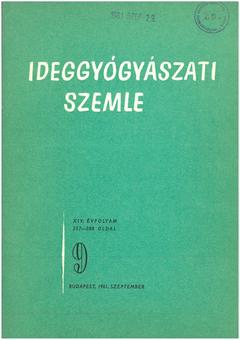The eLitMed.hu medical portal uses computer cookies for convenient operation. Detailed information can be found in the Cookie-policy.
Clinical Neuroscience - 1961;14(09)
Content
[Our experience in the diagnosis and treatment of infectious myelitis ]
[The case histories we have reported have clearly demonstrated that often a wrong diagnosis is made, especially in the case of spinal tumours, as they do not analyse the course of the disease properly, do not study the dynamics of the CSF condition, do not use modern methods of treating inflammatory processes and, after not obtaining good results with their treatment, send the patient to the Neurological Clinic, thus missing a very important time factor: as a consequence, the patient does not receive the right treatment in time. We need to underline the importance of timely high-dose antibiotic treatment, including lumbar administration in the acute phase of the disease. In addition to antibiotics, of course, we must also use the other treatment methods that we have used in the cases we have reported. ]
[Polyneuritism and neuroparalytic ornithosis]
[The authors describe the case of a 47-year-old male pigeon fancier who contracted ornithosis while handling sick pigeons.Symptoms include: fever with chills, fever lasting for weeks, first continuous and then relapsing, atypical viral pneumonia, polyneuritis, peripheral nerve palsies, arthritis, roseola-like rash and scaly scales. The central nervous system remained intact, consciousness clear throughout. On treatment with Tetran, Hostacyclin, Aureomycin and Chlorocid the patient recovered, the polyneuritis resolved, only the radial and median paralysis remained unchanged. Diagnostic evaluation of the complement fixation reaction was undertaken. They draw attention to the infestation of the domestic poultry flock and the increasing threat of human ornithosis.]
[Impaired time estimation and cochleo-vestibular dysfunctio due to industrial poisoning]
[Both our chemical screening tests and symptoms observed during toxic illness in chemical workers showed signs of central vestibular impairment. The two cases described are special because, on the one hand, both cases of toxic damage were associated with impaired time estimation and, on the other hand, in contrast to the increased reflex sensitivity observed in otoneurological examinations, we found a rare pathology of bilateral hypofunctio in the first case and central cochleovestibular damage in the second. These findings suggest that the symptoms of chemical toxicity can be very diverse and that otovestibular and neurological examinations complement and support each other in the recognition of multicentral lesions. ]
[Glutamic acid oxaloacetic acid transaminase determinations in infants and children neurological diseases]
[Glutamic acid oxaloacetic transaminase (GOT) activity was determined in the cerebrospinal fluid and serum of our infant and pediatric neurological cases. We detected hyperactivity mainly in CSF, occasionally in sacral, especially generalized sacral, chorea rheumatica and hydrocephalus. In the latter, we followed the course of the disease by repeated tests in the CSF. Our studies showed that ferment activity was increased only in cases of severe hydrocephalus and only in certain phases, probably during periods of progression. There was no regular correlation between GOT activity, clinical picture and other laboratory findings, in general only enzyme activity was suggestive of an abnormal brain process. We discussed the mechanism of the increase in ferment activity and, in addition to the well-known factors, we also attributed a role to the histologically detected hypoxic state of brain tissue. ]
[Unconditional and conditional alpha rhythm inhibition interoceptive stimuli in humans]
[Rectally applied intestinal ginger produces electrographic activation in the form of inhibition of alpha waves in humans. This response can be elicited; when associated with a conditional light stimulus, the gut stimulus can induce conditional interoceptive alpha-rhythm inhibition. After 4 to 16 associations of the rectal and light fingers, a conditional interoceptive "wake-up" response occurs, which can be easily extinguished without reinforcement and rebuilt by further associations.]
[Approach to the generating centre of Nystagmus alternans using a drug body]
[Barbiturate and chlorpromazine temporarily eliminate the alternans of nystagmus. During the barbiturate effect, nystagmus can be induced in such patients by caloric stimulation, whereas during the chlorpromazine effect, no caloric reaction can be induced. From these observations it can be concluded that the generating centre of nystagmus alternans is located over the primary vestibular reflex.]
1.
Clinical Neuroscience
[Headache registry in Szeged: Experiences regarding to migraine patients]2.
Clinical Neuroscience
[The new target population of stroke awareness campaign: Kindergarten students ]3.
Clinical Neuroscience
Is there any difference in mortality rates of atrial fibrillation detected before or after ischemic stroke?4.
Clinical Neuroscience
Factors influencing the level of stigma in Parkinson’s disease in western Turkey5.
Clinical Neuroscience
[The effects of demographic and clinical factors on the severity of poststroke aphasia]1.
2.
Clinical Oncology
[Pancreatic cancer: ESMO Clinical Practice Guideline for diagnosis, treatment and follow-up]3.
Clinical Oncology
[Pharmacovigilance landscape – Lessons from the past and opportunities for future]4.
5.



